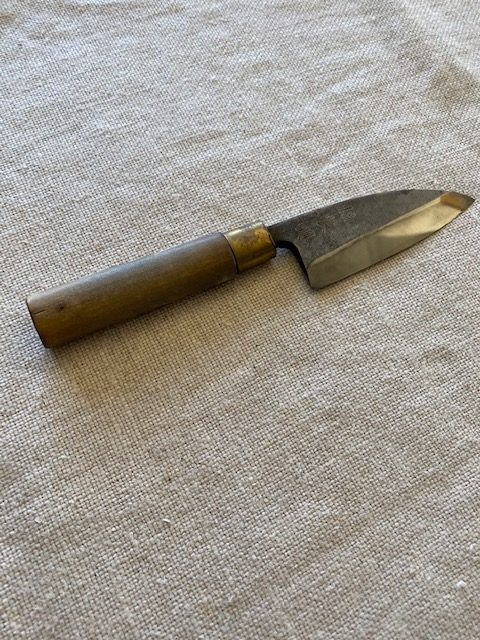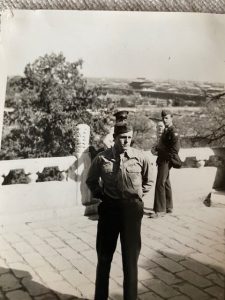 My father brought this knife home from China. He was a U.S. Marine stationed in China in 1944 and 1945. The Marine base was near Peiping (Beijing). Dad hired a man to cook, shop and keep his place neat. His name was Hun Yen Kai. Dad met him when he came to the Marine base looking for a job. This was the knife he used for cooking. Dad told me the knife was Japanese. At the time, I thought that was odd, but after seeing his China photo album, I saw photos of Japanese prisoners housed at his base. I assume the knife probably belonged to one of them.
My father brought this knife home from China. He was a U.S. Marine stationed in China in 1944 and 1945. The Marine base was near Peiping (Beijing). Dad hired a man to cook, shop and keep his place neat. His name was Hun Yen Kai. Dad met him when he came to the Marine base looking for a job. This was the knife he used for cooking. Dad told me the knife was Japanese. At the time, I thought that was odd, but after seeing his China photo album, I saw photos of Japanese prisoners housed at his base. I assume the knife probably belonged to one of them.
 A customer I met through marketing Clairefontaine paper provided some information on the knife. He used our paper in the sharpening process: “This knife would be considered a Wa styled knife, carbon steel, with a kurouchi finish. This finish is a result of the forging process. It is the Western equivalent of a paring or more accurately a utility knife.” “It is a wa-petty knife. The handle is probably made of Ho wood. The characters on the knife are Japanese.” The friend was able to make this translation: “the top is actually 2 kanji, “Tokyo” and the maker is “Hoan2-Ming2” but that’s Chinese not Japanese.” “It is definitely a cooking knife, at least of Japanese style and probably of Japanese origin. The Chinese do make copies of Japanese designs, so that’s why I say probably.” The man who examined and sharpened the knife for me identified it: “It is an ajikiri, used as a filet knife for small fish like trout but particularly mackerel or Aji, which gives the knife its name. It can also be used as a sturdy paring knife for cutting up chicken.”
A customer I met through marketing Clairefontaine paper provided some information on the knife. He used our paper in the sharpening process: “This knife would be considered a Wa styled knife, carbon steel, with a kurouchi finish. This finish is a result of the forging process. It is the Western equivalent of a paring or more accurately a utility knife.” “It is a wa-petty knife. The handle is probably made of Ho wood. The characters on the knife are Japanese.” The friend was able to make this translation: “the top is actually 2 kanji, “Tokyo” and the maker is “Hoan2-Ming2” but that’s Chinese not Japanese.” “It is definitely a cooking knife, at least of Japanese style and probably of Japanese origin. The Chinese do make copies of Japanese designs, so that’s why I say probably.” The man who examined and sharpened the knife for me identified it: “It is an ajikiri, used as a filet knife for small fish like trout but particularly mackerel or Aji, which gives the knife its name. It can also be used as a sturdy paring knife for cutting up chicken.”
I don’t know what became of Hun Yen Kai when the war ended and Dad returned to the U.S. The knife ended up with me, and I have passed it along to my son, Robert. Knives carry their own story and may have their own soul. I think of all the hands that have touched the handle, and all the stories. 
